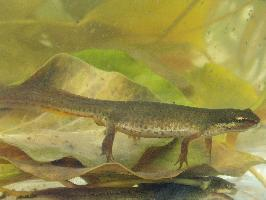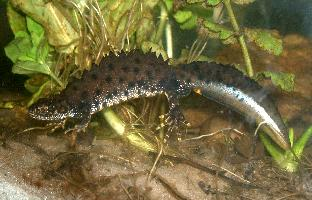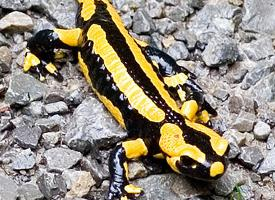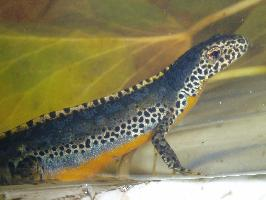
Váhy a míry
| Délka | od 8 do 11 cm |
|---|
Popis zvířete
The Alpine newt (Ichthyosaura alpestris), a fascinating species of salamander in the family Salamandridae, is a small yet captivating creature that thrives in the temperate and often lush environments across much of Europe. With its vibrant colors and intriguing life cycle, this amphibian has garnered the attention of nature enthusiasts and scientists alike.Adult Alpine newts typically measure between 9 to 12 centimeters in length, with males usually being slightly smaller than females. One of the most striking features of the Alpine newt is its vivid coloration, especially during the breeding season. Males exhibit a stunning bright blue dorsal (back) side with a contrasting orange to yellow ventral (belly) side, adorned with dark spots. This dramatic coloration is thought to play a role in attracting females during the mating season. Females, although less colorful, display a more subdued blue along their backs with a yellowish belly, also speckled with black spots. Outside of the breeding season, both sexes adopt a more muted color scheme, blending more seamlessly into their natural surroundings.
Alpine newts inhabit a variety of aquatic and semi-aquatic environments such as ponds, slow-moving streams, and lakes, as well as moist forested areas. They are particularly fond of cool, clear waters in mountainous or hilly regions, hence their name. During the breeding season, which typically occurs in spring, Alpine newts return to the water, where courtship and mating take place. The male performs a unique courtship display to attract a female, which involves a series of movements and the release of pheromones.
Following successful mating, the female lays her eggs individually on aquatic plants. Each egg is carefully wrapped in a leaf for protection. After a period of about two to four weeks, depending on temperature, the eggs hatch into larvae. These larvae are fully aquatic and undergo a metamorphosis over several months, during which they develop legs, lungs, and other adult characteristics. By the end of summer or early autumn, most have completed this transformation and leave the water to begin their terrestrial juvenile stage.
Diet-wise, Alpine newts are opportunistic feeders. Larvae primarily consume small aquatic invertebrates, while adults have a more varied diet that includes insects, worms, and other small invertebrates, both in water and on land.
Alpine newts have a remarkable ability to withstand cold temperatures and can be found at elevations up to 2,500 meters. During the winter months, they hibernate in frost-free refuges such as under logs, rocks, or buried in leaf litter.
Despite their resilience, Alpine newts face threats from habitat loss, pollution, and the introduction of non-native species. In some areas, populations have declined, leading to conservation efforts aimed at protecting their natural habitats and ensuring the species' survival.
In summary, the Alpine newt is a small but strikingly beautiful amphibian with a complex life cycle and behaviors that have adapted it well to the varied climates and habitats of Europe. Its presence enriches the biodiversity of its native regions, making it a species of both ecological importance and aesthetic appeal.
Mapa výskytu
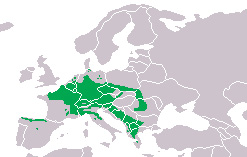
Podobná zvířata
Nové fotografie zvířat
Top 10 zvířat
- Chinese water dragon (Physignathus cocincinus)
- Galápagos tortoise (Geochelone nigra complex)
- Dolphin gull (Leucophaeus scoresbii)
- Japanese macaque (Macaca fuscata)
- Colombian red howler (Alouatta seniculus)
- Sea urchins (Echinoidea)
- Moustached guenon (Cercopithecus cephus)
- Diana monkey (Cercopithecus diana)
- Common reed warbler (Acrocephalus scirpaceus)
- Common house mosquito (Culex pipiens)
